When you buy through our links, we may earn an affiliate commission.
The modern musician is not exactly short of options when it comes to assembling the effects on their pedalboard, but the seemingly endless possibilities can hinder decision-making. One device that is often overlooked in favor of perhaps more transformative effects is the tremolo pedal.
Despite being underrated, choosing the best tremolo pedal can make all the difference to your effects setup. The foundation of any great tremolo pedal is its ability to preserve your instrument's tone and clarity while producing the effect.
Our pick for the best tremolo pedal available is the legendary Boss TR-2, which blends simplicity with versatile volume modulation for a classic tremolo effect.
In addition to providing detailed reviews of the best options, we'll also cover why tremolo is useful, the things you need to consider when selecting a tremolo pedal, and some of the less commonly known tips on how to use these devices.
Best Tremolo Pedals
1. Most Reliable Tremolo Pedal – Boss TR-2 Tremolo Pedal
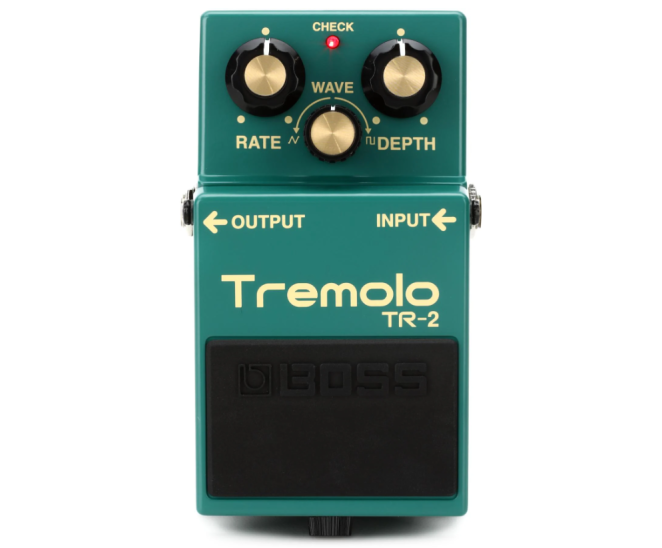
SPECS
- Type: Analog
- Outputs: 1 x 1/4"
- Width: 2.9"
- Bypass Type: True Bypass
Boss pedals often don’t get the credit they deserve. In my experience of using them for many years, they perform excellently while keeping things simple - and that’s exactly what we found when testing the popular TR-2 tremolo pedal. Equipped with the classic three rotary controls that feature on most Boss stompboxes, this pedal creates warm, analog tremolo that instantly reminded me of the onboard effect installed on many ‘60s Fender tube amps.
Although the control layout is minimalistic, you can achieve many different tonal and dynamic variations by tweaking the parameters. The rate control alters the speed of the volume modulation, the wave switches the waveform shape from triangle to square, and the depth control determines the overall intensity of the tremolo effect.
I was particularly impressed by the versatility of the TR-2. Its vintage tone sounded as crisp and rhythmic when used on a clean channel as it did with crunchy overdrive through my tube amp.
What we like about it:
- The TR-2 keeps things simple with a minimalist three-control layout.
- Each control dramatically affects the overall sound and dynamics of the tremolo.
- This pedal sounds equally as good clean as it does with some saturation added to the signal.
What we didn’t like about it:
- The pedal is limited in terms of its inputs and outputs.
- The controls are slightly crowded together, which can make them less easy to adjust while playing.
2. Best Digital Tremolo Pedal – Source Audio Vertigo Tremolo Effect Pedal
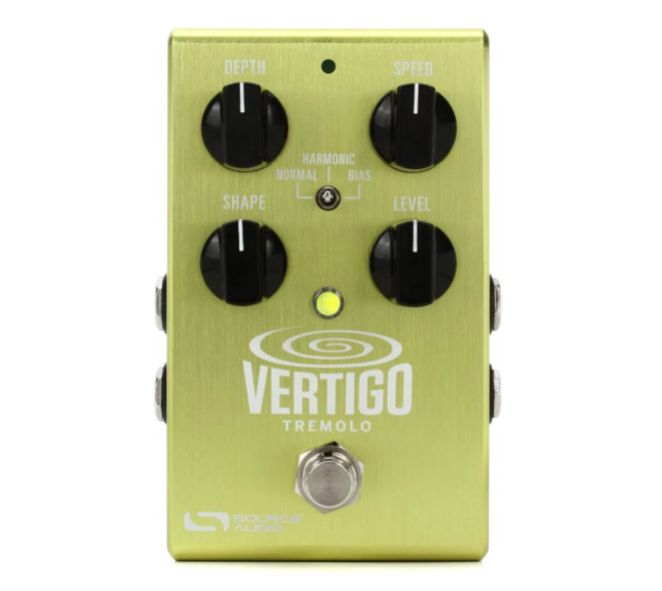
SPECS
- Type: Digital
- Outputs: 2 x 1/4"
- Width: 2.75"
- Bypass Type: True Bypass with Switchable Analog Buffer
The Vertigo pedal by Source Audio is an outstanding digital device that goes above and beyond your average tremolo pedal. One of the things that we enjoyed the most when testing this pedal was its ability to switch between three distinct tremolo presets - each of which closely resembles influential circuits featured on the FX sections of some of the finest vintage tube amps.
If you’re a fan of retro rock n’ roll guitar tones like me, you’ll love playing around with the subtle tube bias-inspired tremolo preset. Combined with a fuzz or overdrive pedal, this setting comes into its own. Then there’s the harmonic preset, which combines phase with vibrato, and the normal optical setting, which delivers warm, rhythmic pulsation.
The onboard volume control is very useful if you play lead guitar parts. I was impressed by its ability to elevate the tremolo effect above the rest of the mix when playing with a band, and it proved to be a good alternative to relying on a boost pedal.
What we like about it:
- The three switchable tremolo presets provide plenty of variety.
- The volume control can act as a substitute for a boost pedal.
- You can access an array of additional settings by connecting the pedal to the Neuro Editor software.
What we didn’t like about it:
- It can be tricky to figure out what the various controls do at first.
- Some of the tones created on the bias mode can sound a little harsh.
3. Best Boutique Tremolo – Strymon Flint Tremolo and Reverb Pedal

SPECS
- Type: Digital
- Width: 4”
- Outputs: 2 x 1/4"
- Bypass Type: True Bypass with Switchable Analog Buffer
Whenever I’ve tried a Strymon effects pedal, I’ve been left impressed by their unique qualities. The Flint is one of the best devices I’ve used by this boutique pedal brand, combining classic tremolo sounds from specific guitar amps from the 1960s complemented by a selection of smooth-sounding reverbs.
We tested a range of playing techniques and musical styles using this pedal, and it performed remarkably well in almost every area. While it is predominantly designed to reproduce the sort of tremolo and reverbs you’d expect to find on an old amplifier, you can create some pretty interesting experimental tones by altering the various controls and blending the two effects.
The Strymon Flint may be one of the most expensive pedals we recommend, but the price definitely reflects its quality. The reverb included with the device is so good that it could easily replace most standalone reverb pedals, potentially saving you some money elsewhere.
What we like about it:
- The pedal authentically recreated vintage tube amp-style tremolo.
- Expression pedal input can be used to control any of the parameters.
- Offers the option of either true bypass or buffered bypass.
What we didn’t like about it:
- The pedal may seem complex to someone who just wants a simple tremolo effect.
4. Best Mini Tremolo Pedal – JHS Tidewater Tremolo Guitar Effects Pedal
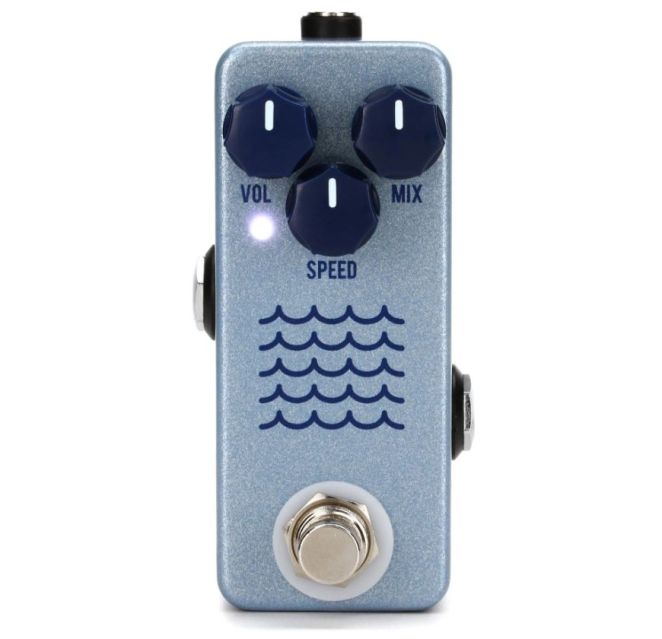
SPECS
- Type: Analog
- Outputs: 1 x 1/4"
- Width: 1.5"
- Bypass Type: True Bypass
When it comes to ease of use, the JHS Tidewater made more of an impression on us than any of the other tremolo pedals we’ve tested. Boasting a simple yet effective three-knob control formation, this is the type of pedal that can be picked up by a complete novice without leaving them confused. Likewise, experienced effects enthusiasts can use the Tidewater to create some excellent tremolo tones.
By altering the speed control, then using the mix control to alter the blend between the wet and dry signals, I was able to create some guitar tones which closely resembled the surf rock style of tremolo that came out of the United States in the mid-1960s. The Blackface style of this pedal makes it highly compatible with analog reverb and overdrive, but you can essentially make it work with any other type of effect by adjusting the three controls.
When using my clean channel, I loved how this JHS pedal subtly added movement to my rhythm guitar playing. A rung-out chord played with a hint of the tremolo effect from this pedal sounds awesome.
What we like about it:
- The controls are very easy to operate and don’t require experience with pedals.
- This pedal delivers authentic-sounding surf-rock tremolo.
- The Tidewater is great at adding slight excitement to clean tones.
What we didn’t like about it:
- The lack of controls isn’t ideal for guitarists who want to shape their tremolo effect deliberately.
5. Best Budget Tremolo Pedal – Ibanez Tremolo Mini Pedal

SPECS
- Type: Analog
- Outputs: 1 x 1/4"
- Width: 1.625"
- Bypass Type: True Bypass
I often find mini effects pedals to be hit and miss, but this tremolo device by Japanese manufacturer Ibanez is one I'd highly recommend to guitarists who need to save space on their pedalboard. The tiny physical size of this pedal made me assume that it wouldn’t produce much of a range of tremolo, but this preconception was proven wrong within moments of plugging my guitar into the input.
There is barely room for the single rotary control that is installed on this pedal, so it’s understandable that Ibanez has kept things very basic when designing it. However, if you look closely at the controls, you’ll notice that along with the main depth knob, there is a small speed and wave knob. After experimenting with these controls, I quickly realized that Ibanez had created a deceptively versatile pedal that is capable of producing a much vaster range of tremolo sounds than is initially apparent.
What we like about it:
- Ibanez has managed to cram a wider range of tremolo variations into this pedal.
- The tiny dimensions make this device easy to slot onto a crowded pedalboard.
- True bypass switching ensures consistent signal strength.
What we didn’t like about it:
- The wave and speed controls are very small and, therefore, tricky to adjust.
- This pedal doesn’t have additional inputs or outputs.
6. Best Analog Tremolo Pedal – Fender MTG Tube Tremolo Pedal
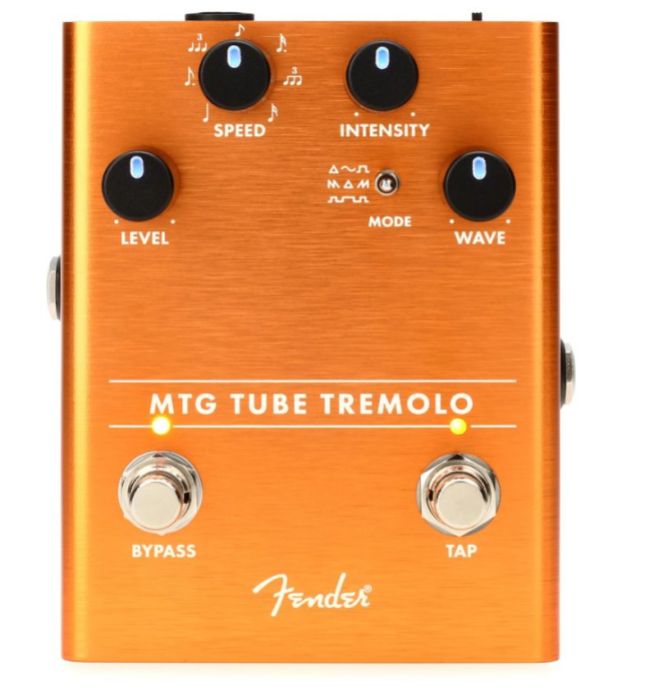
SPECS
- Type: Analog
- Outputs: 1 x 1/4"
- Width: 3.75"
- Bypass Type: True Bypass
One brand that knows a thing or two about tremolo is Fender, whose legendary amps made in the 1960s often included the effect, along with spring reverb. After learning that Fender’s MTG Tube Tremolo pedal was inspired by the legendary NOS 6205 preamp tube, we couldn’t wait to check it out.
Other than the authentic effect that this pedal produced, the feature that most impressed me was the tap tempo. Located on the right side of the pedal’s lower section, the tap tempo is opposite a useful bypass switch, and although it may take some getting used to, once you start to figure out how the feature impacts the speed of the tremolo, it becomes an invaluable tool.
As we’d expect from a Fender-designed device, this pedal's sound quality, build quality, and versatility are all up to scratch. It feels solidly built, and the controls are laid out intuitively, which sped up the process of getting used to using them. If you’re looking for a realistic tube-driven tremolo pedal that gives you complete control over tempo and dynamics, the MTG Tube Tremolo is definitely worth considering.
What we like about it:
- The three switchable presets offer varying flavors of tremolo.
- This pedal features tap tempo function, improving your control over the rhythm.
- The MTG Tube Tremolo is tailor-made for Fender amps.
What we didn’t like about it:
- The aesthetics of the pedal could be improved!
- The pedal has limited connectivity.
7. Best Harmonic Tremolo Pedal – Walrus Audio Monument V2 Harmonic Tap Tremolo Pedal

SPECS
- Type: Analog
- Outputs: 1 x 1/4"
- Width: 3.6"
- Bypass Type: True Bypass
The best tremolo pedals must combine physical attributes like build quality and control layout with sound-related qualities. The Monument V2 by Walrus Audio delivers on all of these fronts, and we found it to be a great all-rounder. At the core of the pedal’s appeal is its tap tempo feature, which puts us in complete control over the rhythmic aspects of the tremolo effect. I found that it works best when the rate control is set at around halfway, as this allowed me to clearly hear the pulsations and time the tap tempo appropriately.
The harmonic tremolo mode is another standout feature of the Monument V2. With this mode selected, I discovered that it provides a great platform for the five waveshapes that the pedal houses - particularly the sine and square settings. I was also very impressed by the versatility of this pedal, finding that it can be used to create simple tremolo effects but is equally adept at producing more experimental and complex modulation.
What we like about it:
- The pedal produces tremolo that suits a wide range of musical styles.
- The tap tempo footswitch is responsive and easy to operate.
- Includes four time division presets for rhythmic variation.
What we didn’t like about it:
- The number of controls can make adjusting them a little confusing.
- It’s easy to accidentally press the bypass switch when using the tap tempo.
8. Most Versatile Tremolo – Supro Analog Harmonic Tremolo Pedal
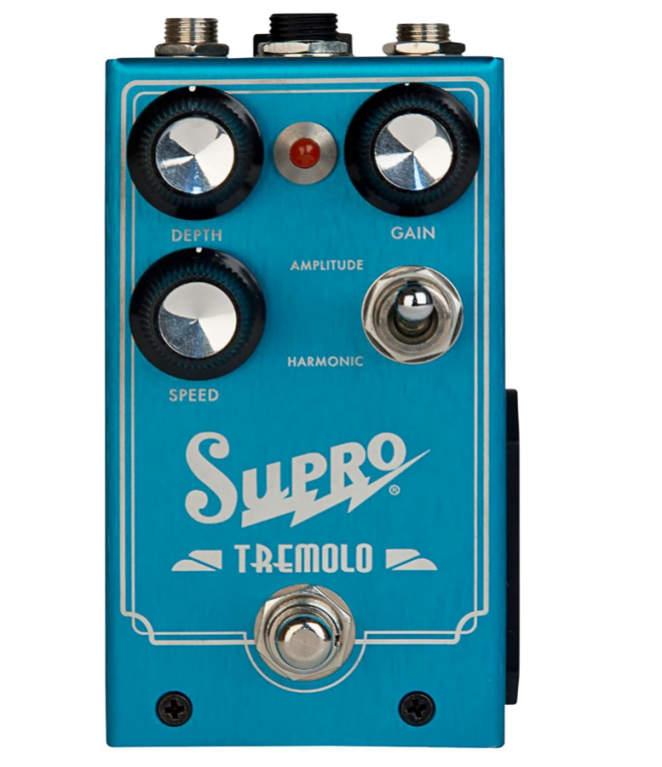
SPECS
- Type: Analog
- Outputs: 1 x 1/4"
- Width: 3.2"
- Bypass Type: True Bypass
Like many of the best tremolo pedals, this Supro device was designed to recreate the legendary onboard modulation effects commonly housed in ‘60s tube amps - and it does this very convincingly. One of the things that stood out when analyzing this pedal is that the all-analog circuitry makes it a perfect fit with other analog pedals - particularly reverbs and gain-based pedals like overdrive.
The Supro Analog Harmonic Tremolo houses harmonic and amplitude modes. Amplitude mode delivers a smooth, vintage tremolo, while the harmonic mode injects some filters into the mix. I tried the latter preset while playing some psychedelic rock-style guitar parts, and it sounded excellent for this purpose. The control that I found most useful was the gain knob, which essentially allows you to add saturation along with the tremolo effect, and like any of the other parameters, this can conveniently be controlled with an expression pedal.
What we like about it:
- The combination of harmonic and amplitude tremolo improves versatility.
- Overdrive can be added to the output using the gain control.
- The pedal is compatible with the majority of expression pedals.
What we didn’t like about it:
- The pedal doesn’t have a tap tempo feature.
Tremolo Pedals Buyer's Guide
When it comes to choosing the best tremolo pedal to add to your setup, there are several important things that need to be considered. While tremolo isn’t the most complex of effects, pedal manufacturers are always looking for ways to improve their designs and innovate, which has expanded these devices' capabilities.
If you’re still unsure which tremolo pedal best suits your requirements, the information in this buyer’s guide will bring some clarity to your situation. We’ll be covering everything from the basics of choosing between analog and digital tremolo pedals to the ways that the different controls impact the way the effect sounds and all of the other important things you need to be aware of before making your decision.
Things to Look For When Buying a Tremolo Pedal
Sound Quality
For a tremolo pedal to be effective, it needs to retain the sound quality of your guitar or other instrument’s signal. It should produce a rich tone with plenty of warmth and vintage character.
Ease of Use
Ideally, you’ll want to choose a tremolo pedal that is simple to operate and doesn’t require a lot of getting used to. Tremolo is a fairly straightforward effect, so using the device shouldn’t be overcomplicated.
Build Quality & Durability
The best tremolo pedals must be roadworthy and able to withstand the inevitable rigors of being used for rehearsing, performing, and being transported is essential. An all-metal housing is the most durable design available.
Connectivity & Power Options
If you want to have more options available when connecting the pedals in your signal chain, choosing a tremolo effects pedal with multiple outputs will afford you more freedom in this area.
Versatility
The more controls a tremolo pedal has installed on it, the more versatile it is likely to be. Depth, rate, and wave are the three staples of tremolo effects, but some manufacturers may include other dynamic and tone-altering parameters.
Analog vs. Digital Tremolos
The tremolo sound is produced through the modulation of volume, and this is what all of these guitar pedals are designed to do. However, manufacturers can use two pedal designs to create this effect.
If the aim is to create a vintage tremolo that sounds warm and smooth, the manufacturer will opt for an analog design. Using an analog tremolo circuit caters to musicians who are more concerned with the authenticity of their guitar tone rather than having an abundance of control knobs to tweak.
Digital pedals are more likely to include a variety of tremolo modes and other adjustable parameters like a tap tempo control, speed knobs, volume knobs, mix knobs, and a wave control. While they may not be capable of recreating the exact vintage amp style wobble that analog pedals can, they are likely to provide you with more freedom to alter the tonal and dynamic aspects of the effect.
Optical and Harmonic Tremolo Pedals
In addition to choosing between analog tremolo pedals and those of the digital variety, you'll also need to be aware of two other main tremolo types - optical and harmonic.
An optical tremolo pedal works by modulating the signal from your instrument using a device known as an optocoupler. This design results in a smooth and consistent tremolo speed and is therefore used by manufacturers who are looking to create tasteful amp-style tremolo pedals.
Many of the best tremolo pedals use a harmonic design, like the Walrus Audio Monument V2 that we tested. These devices are great at producing the pulsating tremolo that is perhaps less conventional than the tremolo produced by optical pedals, making them ideal for more experimental styles of music.
If you want to have all the tremolo effects and sounds at your disposal, then a harmonic device is probably the best option, but if you want to recreate the classic tremolo found on early Fender amps then I'd recommend an opto tremolo.
Multi-FX Tremolo Pedals
Tremolo and reverb effects are often combined into one pedal, but this connection dates back to the designs of guitar amps from the 1960s. Manufacturers like Fender and Vox commonly installed tremolo combined with spring reverb in the FX section of their amps to offer guitarists more tonal flexibility.
In those days, effects pedals were prone to noise issues and not as reliable as they are today, so having built-in effects was very useful to guitar players.
If you're looking for an affordable tremolo pedal, opting for a standalone, simple pedal like the Ibanez Mini Tremolo is probably a better idea.
If you're willing to invest more to access a range of reverb sounds and tremolo tones, choosing a device like the excellent Strymon Flink Tremolo and Reverb pedal might be a good idea.
Two-in-one pedals often come with more adjustable controls and features. You'll probably find a slope control, wave control, depth controls, staple shape control, and level control knobs installed on most pedals. If you prefer simplicity, a stereo tremolo with a minimalistic control layout like the Boss TR-2 will do the job.
Frequently Asked Questions (FAQs)
What is the difference between tremolo and vibrato?
Tremolo and vibrato are two effects that are commonly confused with one another, but there are some important distinctions between them. Both effects use modulation to alter an audio signal, but that’s where the similarities end.
Tremolo is created by modulating the amplitude, otherwise known as volume, over a period of time. This results in a pulsing effect caused by the fluctuations in volume.
On the other hand, vibrato is produced when the pitch of a sound is modulated over a specific period of time, resulting in more oscillation and tonal variation.
Where should I place the tremolo pedal in my signal chain?
Although pedal placement is something that ultimately comes down to personal preference, there is a suggested blueprint that most musicians use as the foundation of their effects chain.
Tremolo belongs to the modulation family of effects, and these are most often placed around the center of the signal chain, coming after the dynamic and gain-based pedals but before the delay and reverb pedals.
What is tube bias tremolo?
Tube bias tremolo is a unique variety that is created through the modulation of the power tubes’ bias vintage in an amp. This modulation results in the volume of the signal going up and down, thus creating a tremolo effect.
Compared to other varieties of tremolo, tube bias tends to sound warmer, with a slight saturation, making it popular amongst musicians who are looking for a vintage tone.
Closing Thoughts
Identifying the best tremolo pedal is no easy task due to the sheer quantity of excellent options available. Our top recommendation is the solid and reliable Boss TR-2, which is incredibly easy to use but produces a versatile range of classic and modern tremolo tones.
As far as great tremolo pedal deals go, the JHS Tidewater is another great option. Its all-analog circuitry ensures a warm and authentic tremolo tone that suits a variety of musical styles and genres.
Hopefully, by testing these pedals and providing feedback on their performance, we have helped you decide which devices would be a good addition to your pedalboard!
